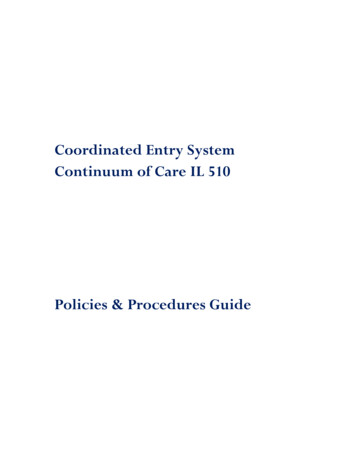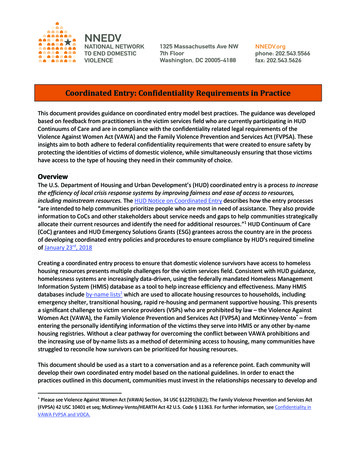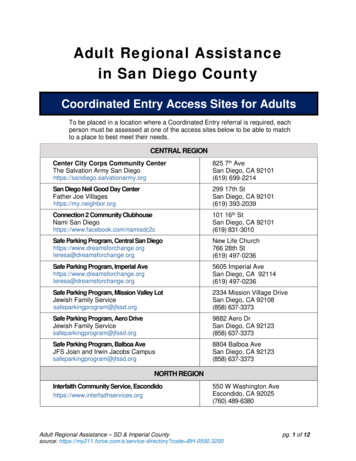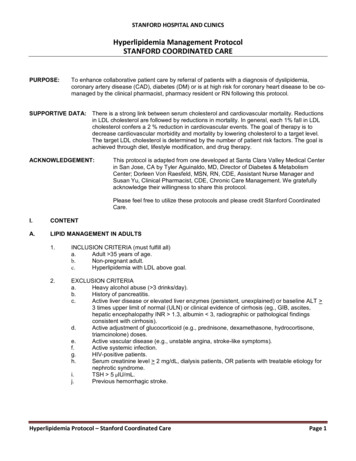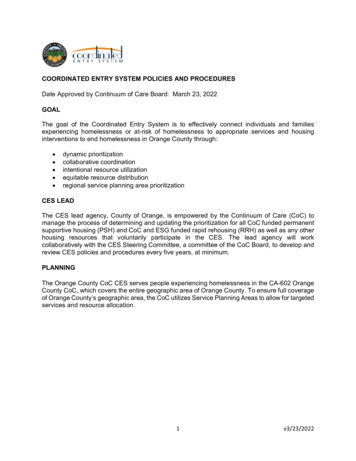
Transcription
COORDINATED ENTRY SYSTEM POLICIES AND PROCEDURESDate Approved by Continuum of Care Board: March 23, 2022GOALThe goal of the Coordinated Entry System is to effectively connect individuals and familiesexperiencing homelessness or at-risk of homelessness to appropriate services and housinginterventions to end homelessness in Orange County through: dynamic prioritizationcollaborative coordinationintentional resource utilizationequitable resource distributionregional service planning area prioritizationCES LEADThe CES lead agency, County of Orange, is empowered by the Continuum of Care (CoC) tomanage the process of determining and updating the prioritization for all CoC funded permanentsupportive housing (PSH) and CoC and ESG funded rapid rehousing (RRH) as well as any otherhousing resources that voluntarily participate in the CES. The lead agency will workcollaboratively with the CES Steering Committee, a committee of the CoC Board, to develop andreview CES policies and procedures every five years, at minimum.PLANNINGThe Orange County CoC CES serves people experiencing homelessness in the CA-602 OrangeCounty CoC, which covers the entire geographic area of Orange County. To ensure full coverageof Orange County’s geographic area, the CoC utilizes Service Planning Areas to allow for targetedservices and resource allocation.1v3/23/2022
All households who meet the U.S. Department of Housing and Urban Development (HUD)definition of homelessness are eligible to participate in CES. For definitions, please seeattachment A.CES serves all individuals and families experiencing homelessness in Orange County regardlessof race, color, national origin, religion, sexual orientation, gender identity, disability, age, sex,familial status, marital status, income, criminal record, or experience with domestic violence,dating violence, sexual assault or stalking.2v3/23/2022
ACCESSThe Orange County CES is operated so that individuals and families seeking housing orsupportive services can easily access services. CES and available housing and supportiveservices are widely advertised throughout the CoC. Marketing strategies include digital andprinted media. By displaying posters, flyers, and resource guides, participating agencies withineach Service Planning Area will support marketing efforts and mainstream partners such aslibraries, schools, police stations, and community centers will be invited to support marketingefforts as well. In some cases, mainstream partners, such as U.S. Department of Veteran Affairs(VA), the Orange County Health Care Agencies (HCA) and Social Services Agency (SSA) FamilyResource Centers, may serve as access points.While marketing will encourage people who are part of a particular cohort to connect withparticular access points for a referral to CES, everyone in need will be accommodated andassisted at any access point. All materials will be affirmatively marketed to eligible personsregardless of race, color, national origin, religion, sex, age, familial status, disability, actual orperceived sexual orientation, gender identity, marital status, criminal history, and those who areleast likely to complete a CES Housing Assessment in the absence of special outreach. Marketingmaterials will also be provided in formats accessible to all individuals, including those withdisabilities and Limited English Proficiency (LEP).Prior to attaining access, individuals or families might encounter a referral partner - an entity oragency that can direct a person experiencing a housing crisis to a CES access point. Examplesof referral partners include medical providers, law enforcement and public agencies such as Parksand Recreation and the Public Library. Though referral partners cannot directly connectindividuals and families to CES, they play a critical, guiding role in connecting individuals andfamilies to emergency services which serve as access points into CES.Access to CES occurs after a person’s immediate crisis needs have been identified and theirbasic client information has been entered into the Homeless Management Information System(HMIS). Throughout Orange County, an array of homeless service providers serves as accesspoints. Access points include mobile street outreach teams, navigation centers, emergencyshelters and a virtual front door. Access points are distributed geographically throughout theCounty in all three Service Planning Areas (North, Central, and South) and the virtual front doorprovides access 24 hours a day through a call center and online access.To facilitate access to CES for veterans and people with disabilities, the VA and HCA are CESpartners with the ability to conduct the standardized CES assessment and participate in theprioritization and referral process.3v3/23/2022
Access ModelThe Orange County CES is comprised of three systems: CES for Individuals, CES for Familiesand a Veteran Registry for Veterans. All CES systems work collaboratively and follow all CESpolicies and procedures.Orange County CoC embraces a Housing First approach and, as such, CES, offers services andhousing to people experiencing homelessness without preconditions (such as sobriety, mentalhealth treatment, or a minimum income threshold) or service participation requirements. In theHousing First model, rapid placement and stabilization in permanent housing are primary goals.Although there are separate systems for individuals and families, the Orange County CES offersa “no wrong door” approach with a standardized assessment at all access points. Initialstandardized screening at each access point allows for immediate linkage to the appropriatesubpopulation access point. This provides individuals and families experiencing homelessness avariety of avenues from which to access housing and supportive services, and no one is turnedaway.Orange County CES does not prohibit or create barriers to available emergency services. Accessto available emergency services are independent of the operating hours or coordinated intakeand assessment processes for CES. Completing the standardized housing assessment is not arequirement and no individual or family will be denied access to the crisis response system basedon willingness to participate in the assessment process. Regardless of people’s willingness tocomplete the standardized CES assessment, people will be warmly welcomed into emergencyshelters and/or other emergency services, as available.AccessibilityOrange County CES ensures that access points are accessible to all individuals, including thosewith disabilities and limited English proficiency. In cases where particular access points areinaccessible for participants for any reason including, but not limited to, structural barriers,language barriers, or transportation limitations, individuals and families will be accommodated atalternative access points or by a street outreach team with the appropriate auxiliary aids andservices necessary to ensure effective communication and completion of the standardizedassessment.Safety PlanningIndividuals and families who are fleeing, or attempting to flee, domestic violence, dating violence,sexual assault, or stalking need specialized assistance that promotes and protects theirconfidentiality and safety. Therefore, while they will have unencumbered access to emergencyservices and CES, appropriate and prompt referrals to services, including hotlines, andemergency shelters specializing in domestic violence are critical. The following domestic violenceresources are available in Orange County:Human Options877-854-3594Interval House714-891-81214v3/23/2022
Laura’s House866-498-1511Women Transitional Living Center714-992-1931877-531-5522Sexual Assault Victim Services (North)714-957-2737Sexual Assault Victim Services (South) 949-831-91102-1-1 Orange County Helpline211949-646-4357888-600-4357Victim service providers are encouraged, but not required, to use CES and/or HMIS.Virtual AccessIndividuals or families experiencing homelessness or at-risk of experiencing homelessness cancall 2-1-1 at any time, day or night, and will be connected with a certified multi-lingual referralspecialist who can make referrals to appropriate emergency services based on individual andfamily service needs and Service Planning Area location.ASSESSMENTCES utilizes a standardized assessment process. The standardized assessment is separated intosections which assist in determining homelessness, vulnerability, strengths, barriers and othercriteria related to eligibility for housing programs. The standardized CES assessment process isconsistent across all access points including street outreach teams.Prior to completing the standardized CES assessment, access points assess and addressimmediate needs followed by efforts to prevent homelessness or divert from experiencing ongoinghomelessness. If referrals to housing resources available through CES are required, access pointstaff begin completing the CES assessment with the individual or family experiencinghomelessness. The CES assessment may be completed during a single session or over time asimmediate needs are addressed and rapport is developed between access point staff and theindividuals or families experiencing homelessness.If an individual is in crisis and requires and chooses shelter, the following steps must be taken: First, provide triage including diversion and prevention; Then, connect the individual or family with shelter as needed and capacity allows and; Finally, follow up to complete the CES assessment.Safety planning is done for all individuals who may be in danger or could be a danger tothemselves or others including identifying appropriate supports and resources. These needs areuncovered through the assessment and responded to immediately to quickly offer appropriatereferral linkages. Accessors will be trained on how to understand when a person is at risk ofharming themselves or others and serve as mandated reporters so that they are equipped to call911 when necessary or connect individuals or families to a local hospital for crisis supports.5v3/23/2022
CES assessments can and should be updated as contact information or life circumstanceschange to ensure a successful referral to an available housing resource and correspondinghousing provider.In support of the participant’s self-determination and autonomy, CES participants are freelyallowed to decide what information they provide during the assessment process, to refuse toanswer assessment questions and to refuse housing and service options without retribution orlimiting their access to other forms of assistance. Participants who decline to complete the CESassessment or provide incomplete information will be informed by the assessor that incompleteassessment information may limit housing opportunities if the incomplete questions are related toeligibility criteria for specific programs.Unaccompanied minors (children ages 17 and younger) will be immediately connected to CasaYouth Shelter (800-914-2272) or Huntington Beach Youth Shelter (714-842-6600) for emergencyshelter and supportive services. The standardized CES assessment may be completed with anunaccompanied minor, as appropriate.Providers serving as access points have completed training on conducting the standardized CESassessment and entering data into HMIS. Updated training is provided at least annually. Ongoingsupport and training are available upon request and as resources permit.The training covers CES policies and procedures including assessment procedures, prioritization,housing referrals, participant privacy, cultural and linguistic competency, safety planning andtrauma-informed practices. Training resources are regularly reviewed and updated as needed butno less than once a year. Training is provided or coordinated by the County of Orange.Each agency participating in CES will assign up to two staff as CES Agency Administrators.Agency Administrators will be required to attend an annual training provided or coordinated bythe County of Orange for CES Agency Administrators. Agency Administrators are responsible forcommunication and training for all CES users and assessors within their organization. AgencyAdministrators are also responsible for quality assurance of assessments and communicationwith the County of Orange regarding staffing changes.PRIORITIZATIONWhen the need for services is greater than resources available, CES utilizes an establishedprioritization schema approved by the CoC Board to connect individuals and families experiencinghomelessness with available housing opportunities. Housing opportunities available through CESinclude Permanent Supportive Housing, Housing Choice Vouchers, Rapid Rehousing, and otherhousing opportunities as they become available. At minimum, all CoC and Emergency SolutionsGrants (ESG) funded housing opportunities will prioritize individuals with the most urgent andsevere needs on the CES prioritization list who are eligible for the housing opportunity. Otherhousing resources will be encouraged, but not required, to participate in CES if privately oralternatively funded.The Orange County CES is integrated into the emergency response services in Orange Countyto meet basic needs, including emergency shelters and transitional shelters. Individuals andfamilies experiencing homelessness or at-risk of homelessness should work with emergencyservice providers and/or call 2-1-1 to receive an initial referral to emergency services. Emergency6v3/23/2022
response services will utilize the Orange County CES to connect individuals and familiesexperiencing homelessness with available housing opportunities.Prevention and diversion services are part of CES and may occur prior to engaging in CES orduring the process of participating in CES for individuals and families experiencing homelessnessor at risk of homelessness. Prevention and diversion are key components of CES that should beutilized in case management and housing plans for all individuals and families experiencinghomelessness or at risk of homelessness in Orange County. Individuals and Families at-risk ofhomelessness and in need of homeless prevention services, should dial 2-1-1 to receive a referralto available homeless prevention services. In instances where there are no appropriate preventionreferrals, 2-1-1 will attempt to connect participants to alternate resources.CES prioritization is a dynamic process. CES will prioritize individuals and families with the longestlength of homelessness in the community and highest service needs as determined using CESassessment tools and case conferencing. A regional Service Planning Area distributionprioritization based on the most recent finalized point in time count is used to distribute nondesignated County resources by Service Planning Area to avoid forcing individuals or families tomove long distances unless by participant choice.The primary factors considered during prioritization is length of homelessness and permanentdisabling conditions. Another factor in the prioritization process is connection to shelter, which isaimed at increasing system flow and maximizing limited shelter and housing resources.Exceptions to the prioritization based on length of homelessness and disabling conditions may bemade through case conferencing and as appropriate to meet specialized client needs. In addition,case conferencing will be employed to ensure housing resources are aligned to client needs andpromote effective resource utilization.To facilitate the prioritization process, centralized master prioritization lists have been created forindividuals, families, and veterans experiencing homelessness. In addition, a subset of theindividual prioritization list is maintained monthly as a Top 10% list. To create the Top 10% list,the top 10% of individuals based on length of homelessness are selected as a sub-set of themaster prioritization list. Individual matches are made from the Top 10% list unless no appropriatematches are available at which point, matches are made from the larger master prioritization list.The purpose of the Top 10% list is to focus CES efforts and support a high level of engagementfrom agencies participating in CES as well ensure the most effective and appropriate use ofavailable resources.All housing opportunities available through CES will prioritize chronically homeless individualsand families that are the most appropriate referral to the available resource. Chronically homelessindividuals and families with the longest length of homelessness and with the most significantservice needs will be prioritized over chronically homeless individuals and families with shorterlengths of homelessness and less significant needs following the prioritization process describedabove.Housing opportunities provided by public housing authorities that are not funded through the CoC(ex. Housing Choice Vouchers) will be prioritized by CES in compliance with the administrativeplan for each public housing authority jurisdiction. Prioritization and case conferencing will beused to refer individuals and families who are the most appropriate referral to the availableresource.7v3/23/2022
Tenant-based and project-based PSH tenants are permitted to move between PSH opportunitiesand/or graduate to HCVs, as available and eligible. Movement between PSH opportunities isdetermined and agreed upon by the housing providers. Vacancies created through tenantmovement must be refilled through CES using CES prioritization criteria.Housing opportunities that serve a specific target population may receive referrals of that targetpopulation. To target a specific population outside of existing practices and community standards,housing providers must provide documentation to CES of receipt of funding that specifies thefunder-defined targeting criteria prior to receiving a referral. Housing providers with targetedhousing opportunities will receive referrals from CES that meet the stated targeting criteria,following the system wide prioritization policy for matches.Participants remain enrolled in CES until the participant is permanently housed, opts out ofparticipating in CES, or becomes inactive. Participants will be made inactive on the prioritizationlist after 90 days of non-engagement with access points or participating agencies.Scenario 1: CES receives 5 HCVs for non-elderly individuals. Based on the 2019 Point in Timeresults, homeless households were distributed throughout Orange County’s Service PlanningAreas as follows: 40% North, 49% Central, and 11% South. Therefore, the vouchers will bedesignated as follows: 2 North Service Planning Area, 2 Central Service Planning Area, and 1South Service Planning Area. Starting with the Top 10% list, sheltered individuals experiencingchronic homelessness with the longest lengths of homelessness are matched to theseopportunities. If no sheltered matches are available, unsheltered individuals on the Top 10% listwill be considered prior to considering matches on the master prioritization list. If no individualsexperiencing chronic homelessness are available, individuals with a permanent disablingcondition experiencing homelessness with the longest lengths of homelessness will beconsidered followed by people without a permanent disabling condition with the longest lengthsof homelessness.Scenario 2: A project-based PSH unit becomes available in the North Service Planning Area fora family. Sheltered families experiencing chronic homelessness with the longest length ofhomelessness from the North Service Planning Area are considered first for this opportunity. If nosheltered families experiencing chronic homelessness from the North Service Planning Area areavailable, unsheltered families experiencing chronic homelessness from the North ServicePlanning Area will be considered followed by sheltered families experiencing chronichomelessness from any Service Planning Area will be considered followed by familiesexperiencing homelessness with a head of household with a permanent disabling condition fromthe North Service Planning Area, and then unsheltered families experiencing homelessness witha head of household with a permanent disabling condition from any Service Planning Area will beconsidered. Finally, families experiencing homelessness from the North Service Planning Areawith the longest lengths of homelessness will be considered followed by families experiencinghomelessness from any Service Planning Area.Scenario 3: An RRH opportunity becomes available for homeless individuals. Shelteredindividuals from the Top 10% list with the longest lengths of homelessness are considered firstfor this opportunity. Then, unsheltered individuals from the Top 10% list with the longest length ofhomelessness will be considered before considering individuals on the master prioritization list.Individuals experiencing chronic homelessness with the longest lengths of homelessness areconsidered first for this opportunity. Then, individuals with a permanent disabling condition8v3/23/2022
experiencing homelessness with the longest lengths of homelessness will be considered followedby people without a permanent disabling condition with the longest lengths of homelessness.REFERRALHousing providers share available housing opportunities through HMIS or a comparable databaseselected by the County of Orange. Housing opportunities are discussed weekly at the HousingPlacement Match Meetings (HPMM) and matched to eligible individuals and families as prioritizedby the prioritization schema. The meetings are attended by participating access points, referralpartners and housing providers. All information shared at the HPMM is private and confidential.To attend the HPMM, attendees are required to review client privacy and confidentialityrequirements and attest to complying with the privacy and confidentiality requirements.Upon referral to housing opportunities, access points will continue to support participantsthroughout the housing placement process and, ideally, for a month or more after housingplacement to ensure housing stability is achieved.Upon referral to housing opportunities, housing providers will provide an overview of programexpectations including the share of rent and utility costs to participants and maintain regularcommunication with access point staff and CES. For RRH opportunities, the maximum amount ofrent that a participant may pay can be up to 100% of the rental amount. In general, the goal willbe that participants pay no more than 50% of their income in rent at RRH program completion.When an individual or family declines a housing referral, the participant is returned to theprioritization list and remains on the prioritization list for a new housing referral. The individual orfamily will continue to be prioritized for available housing resources following the prioritizationprocess previously described.Housing providers may deny a referral from CES under any of the following circumstances: Inappropriate referral (ex. Accessibility needs cannot be met)Ineligible referral (ex. New intake information fails to meet eligibility requirements)Participant obtained other permanent housingParticipant is unresponsive after multiple contact attempts to all available contactinformationReferrals denied by housing providers must be made in writing or electronically in HMIS andinclude the reason for denying the referral as well as any information obtained during the referralprocess that ensures accurate participant information and helps improve future referralprocesses.When an individual or family is denied by housing providers, the participant is returned to theprioritization list and remains on the prioritization list for a new housing referral. The individual orfamily will continue to be prioritized for available housing resources following the prioritizationprocess previously described.Housing provider denials may be contested by conference between the housing provider, thereferring agency and the County of Orange. The referred individual or family may also be involvedas able and appropriate.9v3/23/2022
EMERGENCY TRANSFER REQUEST POLICYPer the Violence Against Women Act (VAWA), any household who is a victim of domesticviolence, dating violence, human trafficking, sexual assault, or stalking can request an emergencytransfer under the following circumstances:a. A sexual assault occurred on the premises of their HUD-funded housing program; orb. Who reasonably believed that they are imminently threatened by harm from furtherdomestic violence, dating violence, sexual assault, stalking, or human trafficking if theyremain in that designated HUD-Funded dwelling.A request for an emergency transfer, under these circumstances, does not guarantee immediateplacement, but participants who qualify for an emergency transfer will be given a priority referralover all other applications for the next available, safe unit through CES for which they qualify.If a household is currently enrolled in a HUD-funded housing program and requests an emergencytransfer, the household must follow the housing agency’s internal emergency transfer housingprocess. If the housing program is unable to accommodate the emergency transfer request, thehousing program may request an emergency transfer via CES.PRIVACY AND DATA MANAGEMENTCES, as an extension of HMIS, is required to comply with all HMIS policies and procedures. Allagency staff participating in CES are required to sign and comply with all HMIS policies andprocedures.During CES assessment, assessors are required to obtain participant consent to disclose theirinformation. As needed, consent may be obtained verbally but, ideally, consent will be providedin writing or electronically. When participants consent to disclose their information, they enhancethe ability of CES to assess needs and make appropriate housing referrals. If consent is notobtained, services will not be denied.In the case that full consent is not obtained, please note these special instructions: Do not enterpersonal identifiable information into HMIS. HMIS will automatically generate an anonymous ID.Please retain at least the first page of the CES assessment part I with the HMIS ID and participantname for your records and future housing referrals.GRIEVANCE PROCESSAt any time during the coordinated entry process, participants have the right to file a complaint,should they feel that CES has not complied with the nondiscrimination and equal opportunityprovisions of Federal civil rights law, fair housing laws and requirements, or the CES policies andprocedures. During assessment, all CES participants will be provided with the process for filing acomplaint. All complaints will be addressed in a timely and fair manner. The following threecontacts are provided to participants for the purpose of addressing discrimination or grievanceconcerns: For grievances with Coordinated Entry System policies and procedures, contact OrangeCounty Community Resources at CoordinatedEntry@ochca.com.For service provider related complaints, grievance should be directed to the appropriateservice provider for resolution.10v3/23/2022
For housing program related complaints, grievances should be directed to the appropriatehousing provider for resolution.To file a discrimination complaint, contact the Department of Housing and UrbanDevelopmentthroughtheonlineportal: https://www.hud.gov/program offices/fair housing equal opp/online-complaintEVALUATIONCES will be regularly evaluated to analyze effectiveness and to identify areas for improvement.System performance metrics will be examined semi-annually, at minimum, to monitor adherenceto system benchmarks. Length of time on priority list, placement rates, and returns tohomelessness are sample metrics that will be used to understand system capacity and determinewhere additional resources are needed.In addition, feedback will be solicited from CES participants and participating agencies throughfeedback surveys and focus groups. Participating agencies will be surveyed at least annually andfocus group feedback opportunities will also be provided annually to solicit consumer feedback.Annually, all participants who utilize CES will be offered the chance to complete a feedback surveyand/or participate in focus group feedback sessions held at geographically dispersed locations.The focus groups and surveys will cover all domains of the coordinated entry process, includingintake, assessment and referral, and will be used to gauge participant and agency perception ofsystem quality and effectiveness.The County of Orange, as the lead CES agency, will collect participant and agency evaluationsand analyze system performance. The information collected will be used to recommend updatesto CES, in consultation with a committee of relevant stakeholders. This committee will meet atleast annually to adopt and implement system changes.For the purpose of the evaluation, data analyzed will be de-identified, and feedback will not requirea name or other identifiable information. This will be used to ensure participant and participatingagency privacy during the evaluation process.CES DOCUMENTS AND REGULATIONSThe above policies and procedures replace all previous versions of the Coordinated Entry System(CES) policies and procedures and are intended to ensure that all agencies participating in theOrange County CES comply with the following regulations:HUD Coordinated Entry Notice CPD-17-01 - Notice Establishing Additional Requirements for aContinuum of Care Centralized or Coordinated Assessment SystemHUD Prioritization Notice CPD-16-11 – Notice on Prioritizing Persons Experiencing ChronicHomelessness and Other Vulnerable Homeless Persons in Permanent Supportive HousingContinuum of Care (CoC) Program Interim Rule 24 CFR 578Emergency Solutions Grants Interim Rule 24 CFR 576HUD Equal Access rule: 24 CFR 511v3/23/2022
12v3/23/2022
ATTACHMENT A – Ho
regional service planning area prioritization CES LEAD The CES lead agency, County of Orange, is empowered by the Continuum of Care (CoC) to manage the process of determining and updating the prioritization for all CoC funded permanent supportive housing (PSH) and CoC and ESG funded rapid rehousing (RRH) as well as any other




